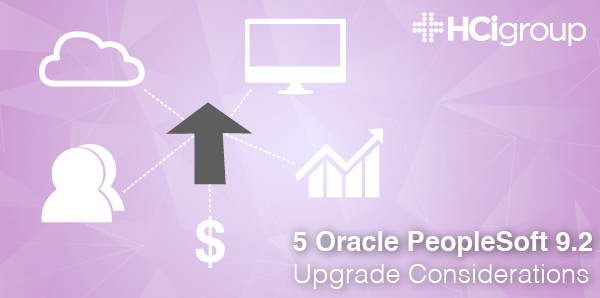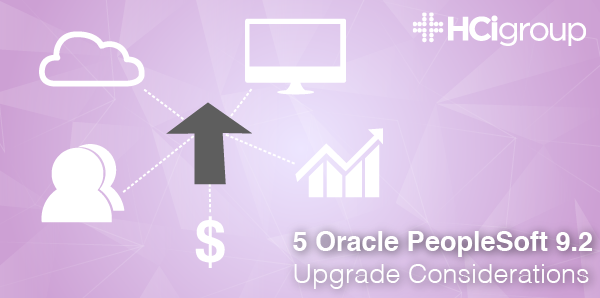5 Oracle PeopleSoft 9.2 Upgrade Considerations


Staying current with Oracle PeopleSoft releases is important. There are many reasons for upgrading, including: taking advantage of the latest functionality, multi-dimensional analytics, better credit to cash, enhanced payables operations and leveraging the latest technical platforms.
The big takeaway is that preparing and executing an upgrade schedule is critical to maximizing your organization’s investment in an enterprise resource planning environment. This blog post looks at a few budget considerations that should be front of mind when planning your next Oracle PeopleSoft upgrade.
Oracle PeopleSoft Upgrade Budget Responsibility
While a fair amount of the costs associated with an Oracle PeopleSoft upgrade fall within the realm of information technology (IT) responsibility, there are additional cost elements within the organization outside of IT that contribute to an upgrade of Oracle PeopleSoft. It is important to start with a communication plan to key stakeholders within the organization that includes:
- What do the upgrade(s) entail?
- When will the upgrade(s) occur?
- Why are the upgrade(s) necessary?
- How will the organization be affected?
Through this dialogue, cost contributors such as temporary Oracle PeopleSoft staff augmentation and overtime expense from activities such as integrated testing, configurations, increased staffing during downtimes, etc. will reveal themselves.
Within IT, cost variables that are commonly associated with an Oracle PeopleSoft upgrade include infrastructure, software licensing, labor, configuration, training, testing and cutover.
1. Infrastructure & Software
It is important to ensure that deployed infrastructure meet or exceed the necessary requirements for its most current releases. However, you will also need to understand and account for impacts to its overall enterprise architecture to identify technical constraints such as compatibility challenges, training on new technology, impacts of upgrading operating systems, database engines, storage area networks, etc.
Cloud vs. On-premise Data Center Considerations
Storage considerations need to account for at least a year-long temporary Oracle PeopleSoft environment dedicated to testing for the upgrade. Therefore, this may require investment in additional disks and/or drive shelves. It is strongly suggested that if a comparison has not yet been performed, consider completing it as soon as possible. The potential costs of hardware refreshes, software licensing and potential infrastructure upgrades can be substantial and require ample lead time for procurement. Lastly, upgrade investments are not limited to solely the production infrastructure. Disaster recovery and system high availability implications also need to be considered and may also have a significant budgetary impact.
2. Labor/Staff
The effort required for planning, new feature configuration, testing and executing a successful upgrade is considerable. The greater the number of interfaces to ancillary systems, the higher the degree of complexity of testing becomes, which in turn equates to additional hours dedicated to the upgrade activity. You will need to quickly assess the capacity available with current staff to absorb the activities associated with an upgrade while also being able to maintain support and already allocated hours to projects. The PMO will need to assess the impact of leveraging internal resources for support of the upgrade. If there are resource constraints that prohibits additional capacity from being realized or possibly causing a delay with other projects, then the costs of temporary labor in the form of Oracle PeopleSoft staff augmentation may prove to be necessary and thus contribute to the overall budget.
3. Training
An early determination to what degree the significance of the Oracle PeopleSoft upgrade’s functions/features, look and feel, etc. have on the impacted end user community will drive the decision on how training will be delivered. Obviously, classroom-based training will present the greatest challenge relative not only to cost, but also logistics for room and resource scheduling, as well as required time away from patient care. If classroom training is deemed necessary and space is at a premium, then the cost of securing temporary space outfitted with connectivity to the testing domain will add cost to the budget. Delivering training via a learning management system (LMS) is a more cost-effective approach, and if you can effectively train the client base in this manner, it is highly encouraged. Developing training curriculum, regardless of delivery method, is another upgrade activity that will consume hours that will need to be accounted for within the budget.
Training for the IT service desk before the upgrade needs to be accounted for, so that the team to be most effective, post-upgrade. Training may require coordination during off-shift hours for personnel and thus have a budgetary impact that accounts for overtime and comp time. Consider an assessment of the current mode of operations of the IT service desk to determine whether an alternative support model for Oracle PeopleSoft should be considered. The return of investing in the effort to upgrade can significantly be reduced without an effective support model.
4. Testing
Decisions on the number of rounds of unit, integrated and user acceptance testing have a bearing on the costs associated with testing. Inclusion of end users to test workflows at the last stage is critical to the success of the upgrade, but also pulls clients away from their daily functions. Backfilling with temporary labor for clients to participate in testing may be necessary to maintain a committed project plan.
Lastly, if not already developed, commit time early on to the development and creation of testing scripts that can be used for both current and future upgrades.
5. Cutover
Consider a temporary command center approach for the cutover from one version to the other. The duration in which the command center is to remain operational will be determined by the degree of variability in going from one version to the other. While the exact duration of operation will yield variability, incorporating the plan to staff a command center into a proposed budget is best identified early in the process.
